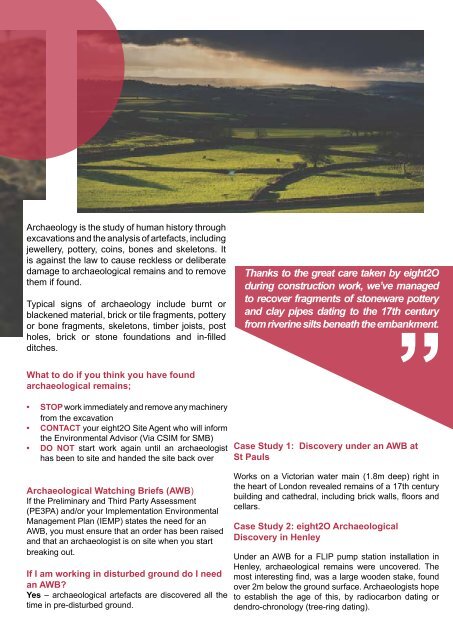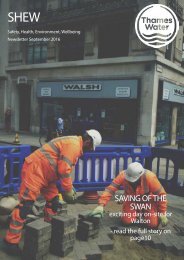junenews
Create successful ePaper yourself
Turn your PDF publications into a flip-book with our unique Google optimized e-Paper software.
Archaeology is the study of human history through<br />
excavations and the analysis of artefacts, including<br />
jewellery, pottery, coins, bones and skeletons. It<br />
is against the law to cause reckless or deliberate<br />
damage to archaeological remains and to remove<br />
them if found.<br />
Typical signs of archaeology include burnt or<br />
blackened material, brick or tile fragments, pottery<br />
or bone fragments, skeletons, timber joists, post<br />
holes, brick or stone foundations and in-filled<br />
ditches.<br />
What to do if you think you have found<br />
archaeological remains;<br />
Thanks to the great care taken by eight2O<br />
during construction work, we’ve managed<br />
to recover fragments of stoneware pottery<br />
and clay pipes dating to the 17th century<br />
from riverine silts beneath the embankment.<br />
“<br />
• STOP work immediately and remove any machinery<br />
from the excavation<br />
• CONTACT your eight2O Site Agent who will inform<br />
the Environmental Advisor (Via CSIM for SMB)<br />
• DO NOT start work again until an archaeologist<br />
has been to site and handed the site back over<br />
Archaeological Watching Briefs (AWB)<br />
If the Preliminary and Third Party Assessment<br />
(PE3PA) and/or your Implementation Environmental<br />
Management Plan (IEMP) states the need for an<br />
AWB, you must ensure that an order has been raised<br />
and that an archaeologist is on site when you start<br />
breaking out.<br />
If I am working in disturbed ground do I need<br />
an AWB?<br />
Yes – archaeological artefacts are discovered all the<br />
time in pre-disturbed ground.<br />
Case Study 1: Discovery under an AWB at<br />
St Pauls<br />
Works on a Victorian water main (1.8m deep) right in<br />
the heart of London revealed remains of a 17th century<br />
building and cathedral, including brick walls, floors and<br />
cellars.<br />
Case Study 2: eight2O Archaeological<br />
Discovery in Henley<br />
Under an AWB for a FLIP pump station installation in<br />
Henley, archaeological remains were uncovered. The<br />
most interesting find, was a large wooden stake, found<br />
over 2m below the ground surface. Archaeologists hope<br />
to establish the age of this, by radiocarbon dating or<br />
dendro-chronology (tree-ring dating).

















